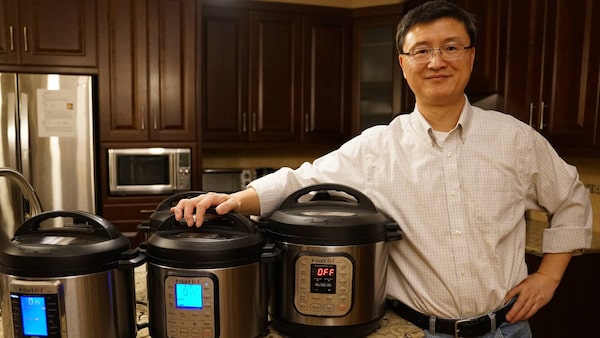
First introduced in 2010, the Instant Pot, invented by Robert Wang and two others, uses technology to take countertop cooking to the next level.Jiwei Wang
Necessity, as the saying goes, is the mother of invention. So, too, is the need for a hot and healthy meal after a long workday.
Such was the case when Robert Wang, a former Nortel engineer and computer science PhD, began searching for ways to improve the electric pressure cooker along with partners Yi Qin and Dongjun Wang.
At that point, the relatively simple household appliance hadn't seen much in the way of innovation since its introduction after the Second World War.
"My wife and I realized that because both of us had jobs, fixing a healthy dinner at home was challenging," says Dr. Wang, who spent most of his career working in the mobile Internet and smartphone space. "You get home at 6, dinner is ready at 8:30. That isn't good. We wanted to create something that could automate the cooking process."
The result was the Instant Pot, which Dr. Wang describes as a multifunctional smart cooker – a major understatement if there was one.
First introduced in 2010, the Instant Pot uses technology – most contemporary small appliances lack microprocessors altogether – to take countertop cooking to the next level. The device is an electric pressure cooker, slow cooker, yogurt maker, rice cooker, porridge maker, steamer, sterilizer, warming pot and sauté pan. One of the latest iterations even has Bluetooth connectivity.
It's also wildly popular, with at least one model vaulting to the top of sales rankings across all categories on Amazon.com – a major success for a tiny company based in Ottawa that only recently expanded to 50 employees from 25 at the start of 2016.
While Dr. Wang won't disclose the Instant Pot Co.'s revenue, the founder and chief executive officer will say that the firm has grown more than 200 per cent annually over the past four years, with the same gains expected this year. The product was designed in Canada and is manufactured in China.
What's remarkable is that the Instant Pot is a runaway export success story, with the vast majority of its customers in the United States but also in Britain and Europe. More than 90 per cent of sales have come from outside Canada.
A visit to the company's social media pages finds messages from eager customers in overseas markets asking where they, too, can buy an Instant Pot – not to mention a passionate global community of aficionados who share recipes and cooking tips.
Building a business on strong exports was a strategic focus for Dr. Wang and his colleagues since the beginning. Achieving this meant prioritizing product design and functionality above all else, he says.
"You cannot just blindly do something and ship to a different country and expect it to sell well," he explains. "You have to look at the lifestyle of the people over there. When we designed the product, we had the U.S. market in mind. Consumerism is strong there and … people love to buy new products."
Indeed, the Instant Pot team studied the demographic mix in major U.S. markets as well as current and traditional culinary trends.
The appliance was thus designed to cater to ethnic and cross-cultural appetites, too. It has a chili-making function to tempt spicy food lovers, a setting for yogurt for Southeast Asian customers, and a custom porridge-making function for Americans who want healthier breakfast options.
What Dr. Wang quickly learned is that cracking the highly competitive U.S. small-appliance market is no easy feat. Warehousing and distribution alone can be deal-breaking challenges.
So, rather than making costly logistics investments, Dr. Wang and his team turned to Amazon and its Fulfillment By Amazon service, essentially outsourcing the job and mitigating most of the risks that come with rapid growth.
The online retailer manages shipping, warehousing and delivery of Instant Pot products at a "reasonable price," leaving his team to focus on developing new products and building a solid online reputation for existing ones.
Interestingly, the Instant Pot Co. spent nothing on advertising until about two years ago. The product's rabid online community helped drive word-of-mouth awareness and online sales with its tweets, Facebook posts, Pinterest pins and Instagram photos of prepared Instant Pot recipes.
"We let the product speak for itself. Cooking is not a solitary event. You invite your friends over for a party and make a wonderful dish, your friends will ask you how you made it and then you'll mention the Instant Pot."
Dr. Wang's relatively tiny customer support staff – the company uses software to automate many of its internal processes – worked with bloggers, chefs and cooking instructors who created recipes to tempt various ethnic palates as well as devotees of vegan, vegetarian, paleo, low-carb and ketogenic diets, to name a few.
Once word spread about the device's multifunctional utility, Dr. Wang and his partners looked for sales further abroad and, with the help of a local distribution partner, eventually established a beachhead in Britain while also making the product available in all Amazon distribution channels across the continent.
With other overseas markets such as his native China in the export crosshairs, Dr. Wang is working to reinvent other legacy kitchen appliances by leveraging technology and catering to contemporary lifestyle needs. The 53-year-old entrepreneur just won't say which ones.
He will offer this piece of advice to other export-minded business owners looking to sell products outside Canada: If you're doing something innovative, consider tapping online tools first.
"Leverage the existing infrastructure from the major players such as Amazon," he advises. "Once you establish the product online, it is very easy to go into offline stores, and that's what we've been doing."